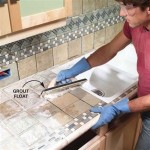Tile For Outdoor Kitchen Countertop: A Comprehensive Guide
The selection of materials for an outdoor kitchen countertop represents a crucial decision, balancing aesthetics, functionality, and durability against the elements. Tile emerges as a popular choice, offering a wide array of design possibilities and inherent resistance to various outdoor conditions. Understanding the nuances of tile selection, installation, and maintenance is paramount for ensuring a long-lasting and visually appealing outdoor kitchen.
Understanding the Advantages of Tile Countertops for Outdoor Kitchens
Tile countertops offer several compelling advantages for outdoor kitchen applications. These benefits stem from the inherent properties of the materials used in tile manufacturing, as well as the flexibility of design they provide. The following points highlight key reasons why tile is a viable option for outdoor kitchen countertops.
Durability and Weather Resistance: Unlike some natural stone options that require significant sealing and are susceptible to staining, cracking, or fading, certain types of tile exhibit excellent resistance to the elements. Porcelain tile, in particular, stands out due to its low water absorption rate, making it highly resistant to freezing and thawing cycles, which can cause cracking in colder climates. This durability extends to resistance against UV radiation, preventing color fading or degradation over prolonged exposure to sunlight. Furthermore, tile is resistant to staining from common outdoor spills, such as food, grease, and even some chemicals, simplifying cleanup and maintenance.
Design Versatility: Tile offers unparalleled design flexibility, allowing homeowners to create a truly customized outdoor kitchen aesthetic. The sheer variety of colors, shapes, sizes, patterns, and textures available in tile is vast. Mosaics allow for intricate patterns and personalized designs, while larger format tiles can create a sleek and modern look. Tile can also mimic the appearance of other materials, such as natural stone, wood, or concrete, offering an alternative for those who desire a specific aesthetic without the associated maintenance challenges. This versatility extends to edge treatments, allowing for bullnose edges, mitered edges, or other custom details to enhance the overall design.
Cost-Effectiveness: While some high-end tile options can be expensive, tile generally offers a cost-effective solution compared to natural stone slabs or specialized outdoor countertop materials. The cost of tile varies depending on the material, size, design, and complexity of the installation. However, budget-conscious homeowners can find attractive and durable tile options that fit within their price range. Furthermore, the longevity and low maintenance requirements of tile countertops can translate into cost savings over the long term, as they require less frequent repairs or replacements compared to some other countertop materials.
Selecting the Right Tile Type for Outdoor Countertops
Choosing the appropriate tile type is critical for ensuring the longevity and performance of an outdoor kitchen countertop. Different tile materials possess varying characteristics, making some more suitable for outdoor applications than others. Careful consideration of these factors is essential for making an informed decision.
Porcelain Tile: Porcelain tile is widely considered the ideal choice for outdoor countertops due to its superior durability and weather resistance. It is manufactured at extremely high temperatures, resulting in a dense and non-porous material with a water absorption rate of less than 0.5%. This low water absorption makes it highly resistant to freezing and thawing cycles, preventing cracking and damage in cold climates. Porcelain tile is also resistant to staining, fading, and scratching, making it a low-maintenance option for outdoor use. Furthermore, porcelain tile is available in a wide range of colors, styles, and textures, including options that mimic the appearance of natural stone, wood, or concrete.
Ceramic Tile: While ceramic tile is a popular choice for indoor applications, it is generally not recommended for outdoor countertops in areas with cold climates. Ceramic tile has a higher water absorption rate compared to porcelain tile, making it more susceptible to cracking and damage from freezing and thawing cycles. However, in warmer climates with mild winters, ceramic tile may be a viable option, particularly for covered outdoor kitchens. It is important to choose a ceramic tile that is specifically rated for outdoor use and to ensure proper sealing to minimize water absorption.
Natural Stone Tile: Certain types of natural stone tile, such as granite or slate, can be used for outdoor countertops. However, natural stone tile typically requires more maintenance than porcelain tile. Natural stone is porous and susceptible to staining, so it needs to be sealed regularly. Certain types of natural stone, such as limestone or travertine, are not recommended for outdoor countertops in cold climates due to their high water absorption rate. If considering natural stone tile, it is important to choose a durable and weather-resistant variety and to properly seal and maintain it to prevent damage.
Considerations for Tile Size and Shape: The size and shape of the tile can also impact the overall look and durability of the countertop. Larger format tiles can create a sleek and modern look, while smaller tiles and mosaics allow for more intricate designs. However, larger format tiles may be more prone to cracking if not properly supported, so it is important to ensure a solid and level substrate. Smaller tiles and mosaics offer better flexibility for complex shapes and curves and can be easier to install around outdoor kitchen appliances. The grout lines between tiles are also a factor to consider. Wider grout lines can provide better traction and slip resistance, while narrower grout lines can create a smoother and more seamless look. It is important to choose a grout that is specifically designed for outdoor use and to seal it properly to prevent staining and water damage.
Installation and Maintenance of Tile Outdoor Kitchen Countertops
Proper installation and ongoing maintenance are crucial for ensuring the longevity and functionality of a tile outdoor kitchen countertop. A well-installed countertop will not only look better but will also be more resistant to damage and weathering. Regular maintenance will help to preserve the beauty and integrity of the tile surface for years to come.
Proper Installation Techniques: The installation process begins with preparing a solid and level substrate. This typically involves constructing a sturdy frame using concrete, wood, or metal, followed by the application of a cement backer board to provide a stable and waterproof surface for the tile. The tile is then applied using a thin-set mortar, ensuring proper spacing and alignment. Grouting is the final step, filling the gaps between the tiles and providing a watertight seal. The type of grout used is important, and epoxy grout is often recommended for outdoor applications due to its superior stain resistance and durability. Professional installation is highly recommended to ensure proper techniques are followed and to avoid potential problems such as uneven surfaces, cracked tiles, or water damage.
Sealing and Protecting the Countertop: Sealing the grout lines is essential for preventing staining and water damage. A high-quality grout sealer should be applied after the grout has cured, and reapplied periodically as needed. In addition, some types of tile, particularly natural stone, may benefit from being sealed to protect them from staining and etching. The type of sealant used will depend on the type of tile and grout. It is also important to protect the countertop from extreme weather conditions. In colder climates, covering the countertop during the winter months can help to prevent cracking and damage from freezing and thawing cycles. Using trivets and cutting boards can protect the tile surface from scratches and heat damage.
Regular Cleaning and Maintenance: Regular cleaning is essential for maintaining the appearance and longevity of a tile outdoor kitchen countertop. The frequency of cleaning will depend on the level of use and exposure to the elements. Generally, wiping down the countertop with a mild soap and water solution after each use is sufficient. For more stubborn stains, a non-abrasive cleaner can be used. Avoid using harsh chemicals or abrasive cleaners, as these can damage the tile and grout. Periodically, the grout lines should be scrubbed with a brush to remove any dirt or mildew buildup. Inspecting the countertop regularly for cracks, chips, or other damage is also important. Addressing any issues promptly can prevent them from escalating and causing further damage. Following these simple maintenance tips can help to keep your tile outdoor kitchen countertop looking its best for years to come.

Outdoor Kitchen Countertops L Trex Kitchens

Outdoor Countertops Counters Bars For Your Kitchen Landscaping Network

Outdoor Kitchen Countertop Ideas Arizona Tile

6 Outdoor Kitchen Countertop Options The Family Handyman

Outdoor Kitchen With Vermont Soapstone Tile Countertop Countertops

What Is The Best Countertop For An Outdoor Kitchen

Best Outdoor Kitchen Countertops Options Cad Pro

Diy Outdoor Kitchen Countertop Options

Best Outdoor Kitchen Tile What Materials To Use Amazing Ideas

How Your Outdoor Kitchen Dimensions Will Guide Design
See Also








